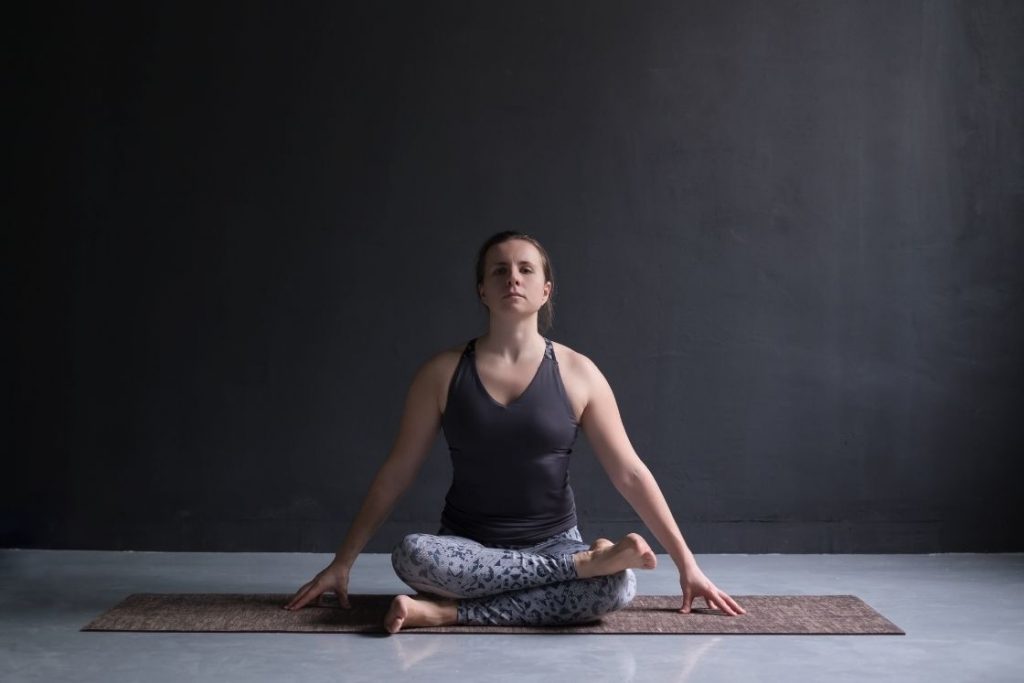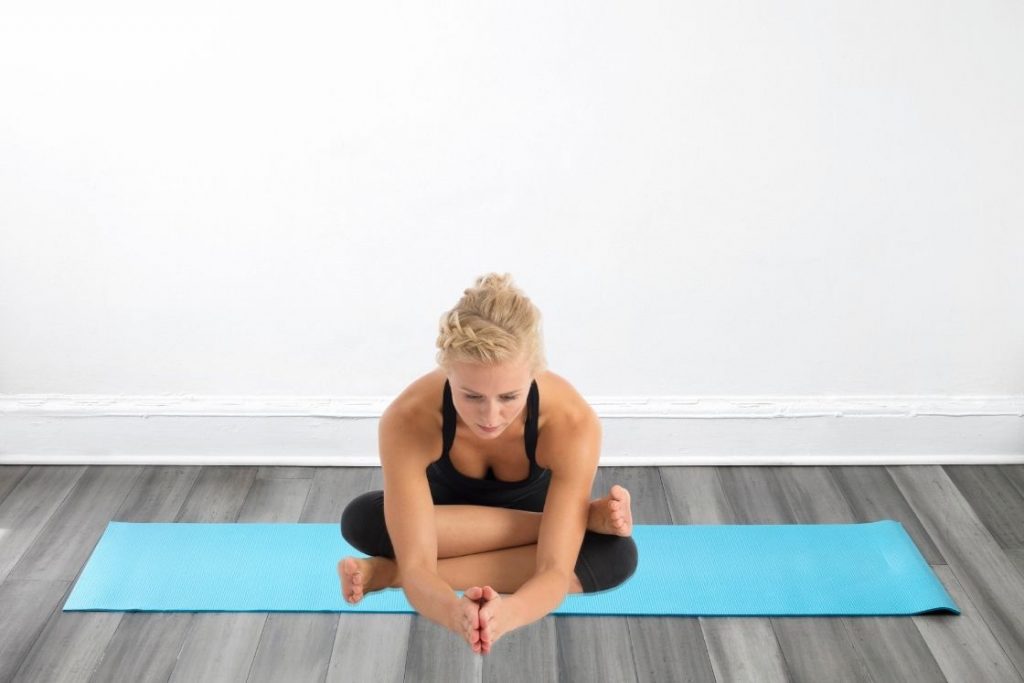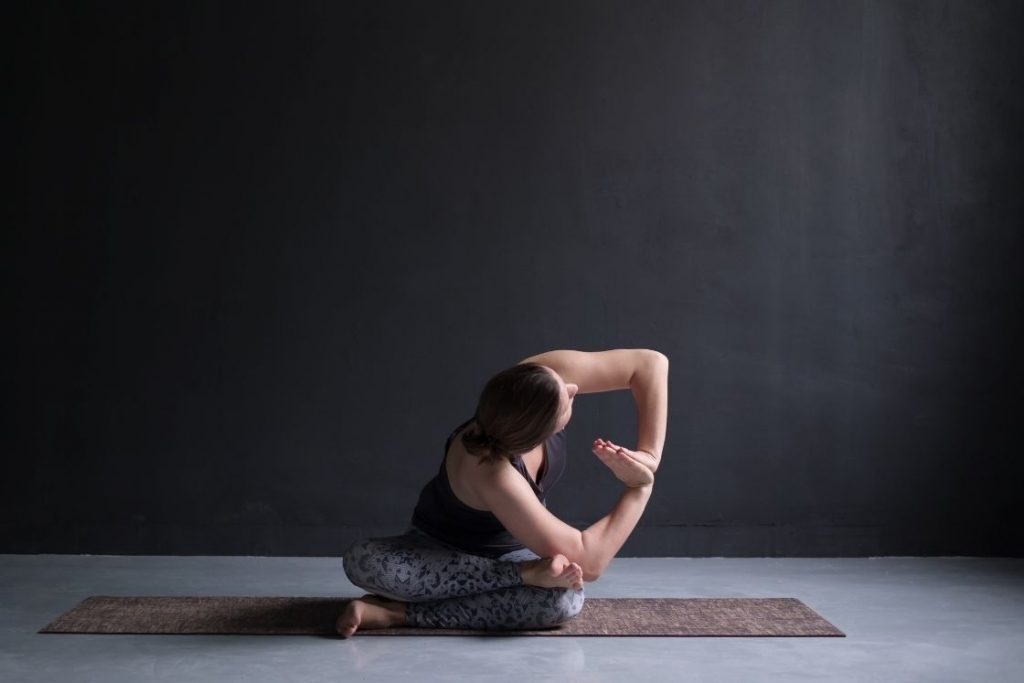
In Hindu Vedic rituals, hearth (Agni) and picket logs (stambha) are used to create a sacred area for prayers and choices, symbolising a reference to the next energy. The Fireplace Log Pose in yoga carries an identical non secular essence, together with its well-known therapeutic advantages notably for relieving sciatic ache.
Fireplace Log Pose, also called Agnistambhasana, is a sophisticated seated yoga posture generally included in hip-opening sequences. It helps launch deep pressure within the hips and promotes flexibility within the decrease physique.
On this pose, the legs are stacked by putting one ankle over the alternative knee and the alternative ankle beneath the opposite knee resembling the form of stacked firewood. The practitioner then folds ahead from the hip joints, sustaining an extended, impartial backbone all through the motion.
That means of agnistambhasana (Fireplace Log Pose)
The identify Agnistambhasana comes from Sanskrit, the place agni means “hearth” and stambha means “log” or “pillar.” In English, this posture is often generally known as Fireplace Log Pose or Burning Log Pose.
Within the closing place of Agnistambhasana, the legs are stacked in a manner that resembles two hearth logs positioned one over the opposite. Practitioners typically really feel an intense stretch or a burning sensation within the hips and pelvis whereas holding the pose additional reflecting the “hearth” facet of its identify.
As a result of the ankle-to-knee leg association on this pose is much like that in Pigeon Pose, additionally it is known as Double Pigeon Pose or Ankle-to-Knee Pose.
Fireplace Log Pose symbolic interpretation
Fireplace Log Pose is known as after hearth thought-about the purest and most transformative factor in lots of non secular traditions. Simply as hearth is used to purify gold, Agnistambhasana symbolises interior purification. Practising this pose helps launch deep-seated pressure from the hips and joints, selling each bodily and emotional cleaning.
Fireplace Log pose follow information

Preparatory poses
do Fireplace Log pose (steps)
- Sit on the ground along with your legs prolonged ahead in Dandasana.
- Gently raise your left knee and slide the left heel towards your pelvis.
- Bend your proper knee and place the proper foot beneath the left knee.
- Maintain the outer fringe of your proper foot parallel to the entrance fringe of the mat.
- Place your left ankle on prime of your proper knee, stacking each shins like hearth logs.
- Sit upright along with your backbone tall and your again straight.
- Convey your fingers in entrance of your legs and place them on the ground.
- Breathe steadily and start strolling your fingertips ahead, going so far as comfy.
- Make sure you’re folding from the hip joints (groins), not bending from the waist or stomach.
- Maintain the pose for 30 to 60 seconds whereas sustaining a gradual breath.
- Inhale and slowly stroll your fingers again towards the physique, returning to an upright place.
- Swap leg positions and repeat the identical steps on the alternative aspect.
- Launch each legs and calm down again in Dandasana.
Newbie’s ideas
- If stacking one leg over the opposite is just too difficult, you may practise a less complicated variation of Agnistambhasana by sitting in Sukhasana (Straightforward Pose) and step by step engaged on hip flexibility.
- Earlier than leaning ahead, gently rotate the thighs outward from the hip joints. This exterior rotation helps open the hips and makes the ahead bend extra accessible.
Precautions & contraindications
- Take sufficient time to heat up the physique, particularly the hips, psoas, and groin space, earlier than practising Fireplace Log Pose.
- Keep away from rounding the again whereas leaning ahead. At all times bend from the hip joints, not from the waist.
- Don’t drive the knees towards the ground or push your self right into a deeper ahead bend than your physique permits.
- Keep away from practising Agnistambhasana when you have any harm within the decrease again, hips, or ankles.
- Individuals with knee accidents or arthritis mustn’t try this pose with out steerage. It’s usually not advisable in such situations.
Comply with-up poses
Modifications
- Folded blanket – Apply agnistambasana sitting on a block in case your pelvis is tilting again. This elevates the pelvis area and avoids slouching of the again.
- Blocks – Place yoga blocks between the underside leg’s ankle and prime leg’s knee. This is not going to exert stress on the hips and nonetheless opens them. You can even place one other block in entrance of your backside shin in order that the highest ankle rests on it. This prevents the hurting of the ankles and stacks the shins.
Variations

- Agnistambhasana Variation 1– From dandasana bend one leg on the knee and place the respective foot on the alternate thigh. Place the fingers by your aspect on the ground. Take 2 breaths and change the legs to repeat the pose.
- Agnistambhasana Leaning Ahead– After attaining agnistambhasana lean additional by bringing your elbows to the ground. Unfold your palms and convey your head to the ground.
- Agnistambhasana Variation Ahead Bend– From agnistambhasana carry your elbows to the ground. Now be part of your palms with fingers pointing ahead and set your gaze to the ground.
- Agnistambhasana Twist – Taking the left leg because the decrease leg in agnistambhasana, carry your proper arm behind your tailbone. Concurrently, place your left hand beside your left foot twisting your torso.
Fireplace Log Pose advantages
Fireplace Log Pose (Agnistambhasana) is greater than only a deep hip opener. It helps joint well being, improves digestion, tones the decrease physique, and helps calm the thoughts. With constant follow, it additionally boosts vitality move within the pelvic space and stimulates creativity.
1. Enhances flexibility
This pose deeply stretches the hips, thighs, and knees. The stress and activation in these areas improve muscle elasticity and stop stiffness or harm. Improved flexibility additionally helps higher blood move and nutrient absorption, strengthening the glutes, groin, and surrounding muscle mass.
2. Reduces fats
The decrease physique is actively engaged whereas holding the posture. This muscular effort helps tone the thighs and hips by burning saved fats, contributing to a leaner decrease physique.
3. Improves digestion
The mild compression on the stomach space stimulates digestive organs. This helps regulate stress hormones and boosts digestive effectivity. Common follow can help wholesome bowel actions and relieve frequent digestive points.
4. Enhances sexual well being
The pose prompts the pelvic area and will increase blood circulation to the reproductive organs. This stimulation might enhance hormonal steadiness and help sexual vitality in each women and men.
5. Heals decrease again ache
Sustaining an upright backbone whereas sitting in Agnistambhasana strengthens the spinal muscle mass and improves posture. It gently stretches the decrease again, serving to to alleviate pressure and scale back power discomfort.
6. Profit the nervous system
When mixed with deep, regular respiration, the pose calms the thoughts and physique. It improves oxygen provide to the mind, serving to scale back stress, nervousness, and psychological fatigue. It additionally helps higher focus and emotional steadiness.
7. Stimulates the sacral chakra
The pelvic opening and pranic motion on this posture assist activate the Svadhisthana (sacral) chakra. This will awaken creativity, uplift temper, and improve emotional intelligence.
